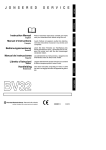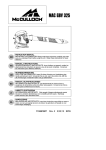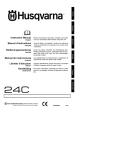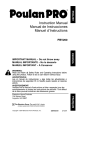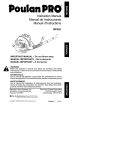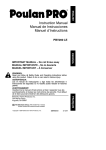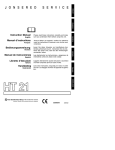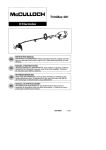Download Electrolux BV32 Instruction manual
Transcript
S E R V I C E ENGLISH J O N S E R E D FRANÇAIS Please read these instructions carefully and make sure you understand them before using this unit. Manuel d’instructions Avant d’utiliser cet appareil, veuillez lire attentivement les instructions et assurez--vous de les avoir comprises. English Français Lesen Sie diese Hinweise zur Handhabung des Geräts aufmerksam durch. Verwenden Sie es erst, wenn Sie sicher sind, daß Sie alle Anweisungen verstanden haben. Manual de instrucciones Lea atentamente las instrucciones y asegúrese de entenderlas antes de utilizar este unidad. Deutsch Español Leggere attentamente queste istruzioni e accertarsi di averle comprese prima di usare l’unità. Handleiding Lees deze instructies zorgvuldig en wees er zeker van dat u ze begrijpt alvorens dit apparaat te gebruiken. Italiano Nederlands ITALIANO Libretto d’Istruzioni ESPANOL Bedienungsanweisung DEUTSCH Instruction Manual NEDERLANDS 530088114 5/28/02 KEY TO SYMBOLS WARNING! This blower can be dangerous! Careless or improper use can cause serious or even fatal injury. Use unleaded or quality leaded petrol and two stroke oil. Read and understand the instruction manual before using the blower. Always wear eye and ear protection. WARNING! Be sure the bottom cover is secured or the vacuum tube is properly installed. Avoid the impeller blade with your hand or any foreign object. Checks and/or maintenance should be carried out with the engine switched off, with the stop switch in the OFF position. Instructions on how to open vacuum inlet cover. SAFETY RULES WARNING: Failure to follow all Safety Rules and Precautions can result in serious injury. PLAN AHEAD D KNOW YOUR UNIT S Read your instruction manual carefully until you completely understand and can follow all warnings and safety rules before operating the unit. D Restrict unit to users who understand and will follow all warnings and safety rules in this manual. WARNING: Inspect area before starting unit. Remove all debris and hard objects such as rocks, glass, wire, etc. that can ricochet, be thrown, or otherwise cause injury or damage during operation. Use your unit as a blower for: D Sweeping debris or grass clippings from driveways, sidewalks, patios, etc. D Blowing grass clippings, straw, or leaves into piles, around joints, or between bricks. Use your unit as a vacuum for: D Picking up dry material such as leaves, grass, small twigs, and bits of paper. D For best results during vacuum use, operate your unit at high speed. D Move slowly back and forth over the material as you vacuum. Avoid forcing the unit into a pile of debris as this can clog the unit. D Keep the vacuum tube about an inch above the ground for best results. D D D D D -- 2 -- Always wear eye protection when operating, servicing, or performing maintenance on unit. Wearing eye protection will help to prevent rocks or debris from being blown or ricocheting into eyes and face which can result in blindness and/or serious injury. Eye protection should be marked Z87. Always wear foot protection. Do not go barefoot or wear sandals. Always wear respirator or face mask when working with unit in dusty environments. Secure hair above shoulder length. Secure or remove jewelry, loose clothing, or clothing with loosely hanging straps, ties, tassels, etc. They can be caught in moving parts. Do not operate unit when you are tired, ill, upset, or if you are under the influence of alcohol, drugs, or medication. Keep children, bystanders, and animals away from work area a minimum of 10 meters when starting or operating unit. Do not point blower nozzle in the direction of people or pets. The operator of the machine must insure that no one comes within a 10 meter radius while working. When several operators are working within the same area, a safety distance of at least 10 meters must be observed. WARNING! The blower can throw objects violently. --You can be blinded or injured. --Always wear eye protection. Thrown objects D HANDLE FUEL WITH CAUTION D D D D D D D D D Eliminate all sources of sparks or flame (including smoking, open flames, or work that can cause sparks) in the areas where fuel is mixed, poured, or stored. Mix and pour fuel in an outdoor area; store fuel in a cool, dry, well ventilated place; use an approved, marked container for all fuel purposes. Do not smoke while handling fuel or while operating the unit. Make sure the unit is properly assembled and in good operating condition. Do not fill fuel tank while engine is hot or running. Avoid spilling fuel or oil. Wipe up fuel spills before starting engine. Move at least 3 meters away from fuel and fueling site before starting engine. Always store petrol in a container approved for flammable liquids. OPERATE YOUR UNIT SAFELY D D D D MAINTAIN YOUR UNIT PROPERLY D D WARNING: Stop the engine before opening the vacuum inlet door. The engine must be stopped and the impeller blades no longer turning to avoid serious injury from the rotating blades. D Inspect unit before each use for worn, loose, missing, or damaged parts. Do not use until unit is in proper working order. D Keep outside surfaces free of oil and fuel. D Never start or run engine inside a closed room or building. Breathing exhaust fumes can kill. D To avoid static electricity shock, do not wear rubber gloves or any other insulated gloves while operating unit. D Do not set unit on any surface except a clean, hard area while engine is running. Debris such as gravel, sand, dust, grass, etc. could be picked up by the air intake and thrown out through discharge opening, damaging unit, property, or causing serious injury to bystanders or operator. D Avoid dangerous environments. Do not use in unventilated areas or where explosive vapors or carbon monoxide build up could be present. D Do not overreach or use from unstable surfaces such as ladders, trees, steep slopes, rooftops, etc. Keep firm footing and balance at all times. D Never place objects inside the blower tubes; always direct the blowing debris away from people, animals, glass, and solid objects such as trees, automobiles, walls, etc. The force of air can cause rocks, dirt, or sticks to be thrown or to ricochet which can hurt people or animals, break glass, or cause other damage. Never run unit without the proper equipment attached. When using your unit as a blower, always install blower tubes. When using your unit as a vacuum, always install vacuum tubes and vacuum bag assembly. Make sure vacuum bag assembly is completely zipped. Check air intake opening, blower tubes, vacuum tubes, and elbow tube frequently, always with engine stopped and spark plug disconnected. Keep vents and discharge tubes free of debris which can accumulate and restrict proper air flow. Never place any object in the air intake opening as this could restrict proper air flow and cause damage to the unit. Never use for spreading chemicals, fertilizers, or other substances which may contain toxic materials. To avoid spreading fire, do not use near leaf or brush fires, fireplaces, barbecue pits, ashtrays, etc. Use only for jobs explained in this manual. D D D D D Have all maintenance other than the recommended procedures described in the instruction manual performed by an authorized service dealer. Disconnect spark plug before performing maintenance except for carburetor adjustments. Use only recommended Jonsered® replacement parts; use of any other parts may void your warranty and cause damage to your unit. Empty fuel tank before storing the unit. Use up fuel left in carburetor by starting engine and letting it run until it stops. Do not use any accessory or attachment other than those recommended by manufacturer for use with your unit. Do not store the unit or fuel in a closed area where fuel vapors can reach sparks or an open flame from hot water heaters, electric motors or switches, furnaces, etc. Store in a dry area out of reach of children. SAFETY NOTICE: Exposure to vibrations through prolonged use of gasoline powered hand tools could cause blood vessel or nerve damage in the fingers, hands, and joints of people prone to circulation disorders or abnormal swelling. Prolonged use in cold weather has been linked to blood vessel damage in otherwise healthy people. If symptoms occur such as numbness, pain, loss of strength, change in skin color or texture, or loss of feeling in the fingers, hands, or joints, discontinue the use of this tool and seek medical attention. An antivibration system does not guarantee the avoidance of these problems. Users who operate power tools on a continual and regular basis must monitor closely their physical condition and the condition of this tool. -- 3 -- WHAT IS WHAT? WHAT IS WHAT? 1. Throttle Lock 2. Spark Plug 3. Nozzle 4. Blower Tube 5. Choke Lever 6. Throttle Trigger 7. ON/OFF Switch 8. 9. 10. 11. 12. 13. Rear Handle Starter Rope Elbow Tube Collection Bag Vacuum tubes Instruction manual 13 ASSEMBLY CARTON CONTENTS Check carton contents against the following list. S Blower S Blower tube S Nozzle S Upper vacuum tube S Lower vacuum tube S Elbow tube S Vacuum bag NOTE: It is normal for the fuel filter to rattle in the empty fuel tank. ASSEMBLY WARNING: Stop engine and be sure the impeller blades have stopped turning before opening the vacuum inlet door or attempting to insert or remove the vacuum or blower tubes. The rotating blades can cause serious injury. Always disconnect the spark plug before performing maintenance or accessing movable parts. WARNING: If received assembled, repeat all steps to ensure your unit is properly assembled and all fasteners are secure. Follow all safety information in the manual and on the unit. D A standard screwdriver is required for assembly. BLOWER TUBE ASSEMBLY 1. Locate the two retention posts on the side of the blower tube. 2. Align the retention grooves on the nozzle with the retention posts on the blower tube and push the nozzle onto the blower tube. 3. Turn the nozzle clockwise until the parts snap in place and are firmly tightened. 4. Align retention grooves on the blower tube with the retention posts in the blower outlet and push the blower tube into the blower outlet. 5. Turn the blower tube clockwise until the parts snap in place and are firmly tightened. -- 4 -- Nozzle Blower Outlet Latch Area Vacuum Inlet Cover Latch Area Blower Tube Retention Posts VACUUM BAG ASSEMBLY 1. Open the zipper on the vacuum bag and insert the elbow tube. 2. Push the small end of the elbow tube through the small opening in the bag. Elbow Tube Small Opening 3. Gently tilt the handle of the screwdriver toward the back of the unit while pulling up on the vacuum inlet cover with your other hand. 4. Hold the vacuum inlet cover open until upper vacuum tube is installed. 5. Align the grooves on the upper vacuum tube with the retention posts inside the vacuum inlet. 6. Insert the upper vacuum tube into the vacuum inlet; twist the upper vacuum tube clockwise until parts snap together. Upper Vacuum Tube Groove Lower Vacuum Tube Zipper Opening NOTE: Make sure edge of the small open- ing is flush against the flared area of the elbow tube. 3. Close the zipper on the bag. Make sure the zipper is closed completely. 4. Remove blower tube from engine. Vacuum Inlet Cover 7. When converting back to the blower feature, make sure latch on the vacuum inlet cover is securely fastened. SHOULDER STRAP ADJUSTMENT (for vacuum use only) 1. Hold the unit as shown. 2. Pass the shoulder strap over your head and onto your left shoulder. Snap the hook onto the strap retainer in the top handle. Elbow Tube Retainer 5. Align grooves on the elbow tube with the retention posts inside the blower outlet. NOTE: For proper alignment, be sure elbow tube is curved to the right as shown. 6. Insert the elbow tube into the blower outlet; twist the elbow tube counterclockwise until the parts snap together. VACUUM TUBE ASSEMBLY 3. Extend your right arm toward the rear of the vacuum bag. 4. Adjust shoulder strap until the vacuum bag/shoulder strap seam lies between your thumb and index finger. 5. Make sure air flows freely from the elbow tube into bag. If bag is kinked, the unit will not operate properly. 1. Align the lower vacuum tube as shown. Push lower vacuum tube into upper vacuum tube. Upper vacuum tube Lower vacuum tube 2. Insert a screwdriver into the latch area on the vacuum inlet cover. -- 5 -- OPERATION OPERATING POSITION FUELING ENGINE WARNING: Remove fuel cap slowly when refueling. This engine is certified to operate on unleaded petrol. Before operation, petrol must be mixed with a good quality 2-cycle air-cooled engine oil. We recommend Jonsered® brand oil mixed at a ratio of 40:1 (2.5%). A 40:1 ratio is obtained by mixing 5 liters of unleaded petrol with 0,125 liter of oil. When mixing fuel, follow the instructions printed on the container. Always read and follow the safety rules before fueling your unit. Eye Protection IMPORTANT BLOWER VACUUM OPERATING TIPS S To reduce the risk of hearing loss associated with sound level(s), hearing protection is required. S To reduce the risk of injury associated with contacting rotating parts, stop the engine before installing or removing attachments. Do not operate without guard(s) in place. S Operate power equipment only at reasonable hours--not early in the morning or late at night when people might be disturbed. Comply with times listed in local ordinances. Usual recommendations are 9:00 a.m. to 5:00 p.m., Monday though Saturday. S To reduce noise levels, limit the number of pieces of equipment used at any one time. S To reduce noise levels, operate power blowers at the lowest possible throttle speed to do the job. S Use rakes and brooms to loosen debris before blowing. S In dusty conditions, slightly dampen surfaces or use a mister attachment when water is available. S Conserve water by using power blowers instead of hoses for many lawn and garden applications, including areas such as gutters, screens, patios, grills, porches, and gardens. S Watch out for children, pets, open windows, or freshly washed cars. Blow debris away safely. S Use the full blower nozzle extension so the air stream can work close to the ground. S After using blowers and other equipment, CLEAN UP! Dispose of debris in trash receptacles. BEFORE STARTING ENGINE WARNING: Be sure to read the fuel information in the safety rules before you begin. If you do not understand the safety rules, do not attempt to fuel your unit. Contact an authorized service dealer. Experience indicates that alcohol blended fuels (called gasohol or using ethanol or methanol) can attract moisture which leads to separation and formation of acids during storage. Acidic gas can damage the fuel system of an engine while in storage. To avoid engine problems, empty the fuel system before storage for 30 days or longer. Drain the gas tank, start the engine and let it run until the fuel lines and carburetor are empty. Use fresh fuel next season. Never use engine or carburetor cleaner products in the fuel tank or permanent damage may occur. STOPPING YOUR ENGINE D To stop the engine, move the ON/OFF switch to the OFF position. BEFORE STARTING THE ENGINE WARNING: You MUST make sure the tubes are secure before using the unit. D Fuel engine. Move at least 3 meters away from the fueling site. D Hold the unit in the starting position as shown. Make sure the blower end is directed away from people, animals, glass, and solid objects. STARTING POSITION BLOWER VACUUM WARNING: When starting engine, hold the unit as illustrated. Do not set unit on any surface except a clean, hard area when starting engine or while engine is running. Debris such as gravel, sand, dust, grass, etc. could be picked up by the air intake and thrown out through the discharge opening, damaging the unit or property, or causing serious injury to bystanders or the operator. STARTING A COLD ENGINE (or a warm engine after running out of fuel) 1. Move the ON/OFF switch to the ON position. -- 6 -- 2. Activate the throttle lock as follows: S Squeeze and hold throttle trigger S Press and hold throttle lock, then S Release the throttle trigger 3. Move choke lever to the FULL CHOKE position. STARTING A WARM ENGINE Throttle Lock Throttle Trigger If engine has not started after 6 pulls (at HALF CHOKE), repeat STARTING A COLD ENGINE procedure. If engine still does not start, proceed to STARTING A FLOODED ENGINE. 9. To stop the engine, move the ON/OFF switch to the OFF position. 1. Move the ON/OFF switch to the ON position. 2. Activate the throttle lock as directed in STARTING A COLD ENGINE. 3. Pull starter rope sharply until engine runs. 4. Release the throttle lock by squeezing and releasing the trigger. NOTE: If engine has not started, pull starter rope 5 more pulls. If engine still does not run, it is probably flooded. 5. To stop the engine, move the ON/OFF switch to the OFF position. Switch Choke Lever 4. Pull starter rope sharply until engine attempts to run, but no more than 5 pulls. NOTE: If engine attempts to start before the 5th pull, go to next step immediately. 5. Move the choke lever to the HALF CHOKE position. 6. Pull the starter rope sharply until the engine runs, but no more than 6 pulls. 7. Run engine for 10 to 15 seconds, then move choke lever to the OFF CHOKE position. 8. Release the throttle lock by squeezing and releasing the trigger. STARTING A FLOODED ENGINE Flooded engines can be started by placing the ON/OFF position in the ON position and the choke lever in the OFF CHOKE position. Activate the throttle lock as directed in STARTING A COLD ENGINE; then, pull rope until engine starts. After the engine starts, squeeze and release the throttle trigger to release the throttle lock and allow engine to idle. Starting could require pulling the starter handle many times depending on how badly the unit is flooded. If unit still doesn’t start, refer to the TROUBLESHOOTING TABLE or contact an authorized service dealer. MAINTENANCE WARNING: Avoid touching muffler unless engine and muffler are cold. A hot muffler can cause serious burns. WARNING: Disconnect the spark plug before performing maintenance except for carburetor adjustments. INSPECT AND CLEAN UNIT & LABELS S After each use, inspect complete unit for loose or damaged parts. Clean the unit and decals using a damp cloth with a mild detergent. S Wipe off unit with a clean dry cloth. CLEAN AIR FILTER Screw CHECK FOR LOOSE FASTENERS AND PARTS S Spark Plug Boot S Air Filter S Housing Screws Air Filter Cover Air Filter CHECK FOR DAMAGED OR WORN PARTS Contact an authorized service dealer for replacement of damaged or worn parts. S ON/OFF Switch -- Ensure ON/OFF switch functions properly by moving the switch to the OFF position. Make sure engine stops; then restart engine and continue. S Fuel Tank. Discontinue use of unit if fuel tank is damaged or leaks. S Vacuum Bag -- Discontinue use of vacuum bag if it is torn or damaged. Cleaning the air filter: A dirty air filter decreases engine performance and increases fuel consumption and harmful emissions. Always clean after every 5 hours of operation or yearly, whichever comes first. 1. Clean the cover and the area around it to keep debris from falling into the carburetor chamber when the cover is removed. 2. Remove parts as illustrated. -- 7 -- NOTE: Do not clean filter in gasoline or other flammable solvent. Doing so can create a fire hazard or produce harmful evaporative emissions. 3. Wash the filter in soap and water. 4. Allow filter to dry. 5. Apply a few drops of oil to the filter; squeeze filter to distribute oil. 6. Replace parts. REPLACE SPARK PLUG Replace spark plug each year to ensure the engine starts easier and runs better. Set spark plug gap at 0.025 inch. Ignition timing is fixed, nonadjustable. 1. Twist, then pull off spark plug boot. 2. Remove spark plug from cylinder and discard. 3. Replace with Champion RCJ-6Y spark plug and tighten securely with a 19 mm socket wrench. 4. Reinstall the spark plug boot. REPLACE FUEL FILTER To replace fuel filter, drain unit by running it dry of fuel, then remove fuel cap/retainer assembly from tank. Pull filter from tank and remove it from fuel line. Install new fuel filter on fuel line; reinstall parts. CARBURETOR ADJUSTMENTS Your carburetor is equipped with limiter caps. Carburetor adjustment is a complicated task. We recommend that you take your unit to an authorized service dealer. Damage may occur if you turn the needles beyond the limiter stops. STORAGE WARNING: Prepare unit for storage at end of season or if it will not be used for 30 days or more. S Allow engine to cool, and secure the unit before storing or transporting. S Store unit and fuel in a well ventilated area where fuel vapors cannot reach sparks or open flames from water heaters, electric motors or switches, furnaces, etc. S Store unit with all guards in place. Position unit so that any sharp object cannot accidentally cause injury. S Store unit and fuel well out of the reach of children. EXTERNAL SURFACES S If your unit is to be stored for a period of time, clean it thoroughly before storage. Store in a clean dry area. S Lightly oil external metal surfaces. INTERNAL ENGINE S Remove spark plug and pour 1 teaspoon of 2-cycle engine oil (air cooled) through the spark plug opening. Slowly pull the starter rope 8 to 10 times to distribute oil. S Replace spark plug with new one of recommended type and heat range. S Clean air filter. S Check entire unit for loose screws, nuts, and bolts. Replace any damaged, broken, or worn parts. S Start each season using only fresh fuel having the proper gasoline to oil ratio. OTHER S Do not store gasoline from one season to another. S Replace your gasoline can if it starts to rust. -- 8 -- TROUBLESHOOTING TABLE WARNING: Always stop unit and disconnect spark plug before performing any of the recommended remedies below other than remedies that require operation of the unit. TROUBLE Engine will not start. Engine will not idle properly. CAUSE REMEDY 1.Engine flooded. 2.Fuel tank empty. 3.Spark plug not firing. 4.Fuel not reaching carburetor. 5.Compression low. 1.Fuel not reaching carburetor. 2.Carburetor requires adjustment. 3.Crankshaft seals worn. 4.Compression low. 1.Air filter dirty. 2.Fuel not reaching carburetor. Engine will not accelerate, lacks power, or dies under a 3.Spark plug fouled. load. 4.Spark arresting screen clogged. 5.Carburetor requires adjustment. 6.Carbon build up. 7.Compression low. 1.Choke partially on. Engine 2.Fuel mixture incorrect. smokes excessively. 3.Air filter dirty. 4.Carburetor requires adjustment. 1.Fuel mixture incorrect. Engine 2.Spark plug incorrect. runs hot. 3.Carburetor requires adjustment. 4.Carbon build up. 1.See “Starting Instructions.” 2.Fill tank with correct fuel mixture. 3.Install new spark plug. 4.Check for dirty fuel filter; replace. Check for kinked or split fuel line; repair or replace. 5.Contact an authorized service dealer. 1.Check for dirty fuel filter; replace. Check for kinked or split fuel line; repair or replace. 2.See “Carburetor Adjustments.” 3.Contact an authorized service dealer. 4.Contact an authorized service dealer. 1.Clean or replace air filter. 2.Check for dirty fuel filter; replace. Check for kinked or split fuel line; repair or replace. 3.Clean or replace spark plug; re-gap. 4.Replace screen. 5.See “Carburetor Adjustments.” 6.Contact an authorized service dealer. 7.Contact an authorized service dealer. 1.Adjust choke. 2.Empty fuel tank and refill with correct fuel mixture. 3.Clean or replace air filter. 4.See “Carburetor Adjustments.” 1.See “Fueling Your Unit.” 2.Replace with correct spark plug. 3.See “Carburetor Adjustments.” 4.Contact an authorized service dealer. U.S. EPA / ENVIRONMENT CANADA EMISSION CONTROL WARRANTY STATEMENT YOUR WARRANTY RIGHTS AND OBLIGATIONS: The U. S. Environmental Protection Agency, Environment Canada and Jonsered are pleased to explain the emissions control system warranty on your year 2001--2004 small off--road engine. Jonsered must warrant the emission control system on your small off--road engine for the periods of time listed below provided there has been no abuse, neglect, or improper maintenance of your small off--road engine. Your emission control system includes parts such as the carburetor and the ignition system. Where a warrantable condition exists, Jonsered will repair your small off--road engine at no cost to you. Expenses covered under warranty include diagnosis, parts and labor. MANUFACTURER’S WARRANTY COVERAGE: If any emissions related part on your engine (as listed under Emissions Control Warranty Parts List) is defective or a defect in the materials or workmanship of the engine causes the failure of such an emission related part, the part will be repaired or replaced by Jonsered. OWNER’S WARRANTY RESPONSIBILITIES: As the small off--road engine owner, you are responsible for the performance of the required maintenance listed in your instruction manual. Jonsered recommends that you retain all receipts covering maintenance on your small off--road engine, but Jonsered cannot deny warranty solely for the lack of receipts or for your failure to ensure the performance of all scheduled maintenance. As the small off--road engine owner, you should be aware that Jonsered may deny you warranty coverage if your small off--road engine or a part of it has failed due to abuse, neglect, improper maintenance, unapproved modifications, or the use of parts not made or approved by the original equipment manufacturer. You are responsible for presenting your small off--road engine to a Jonsered authorized repair center as soon as a problem exists. Warranty repairs should be completed in a reasonable amount of time, not to exceed 30 days. If you have any questions regarding your warranty rights and responsibilities, you should contact your nearest authorized service center or call Jonsered at 1--916--383--3511. WARRANTY COMMENCEMENT DATE: The warranty period begins on the date the small off--road engine is purchased. LENGTH OF COVERAGE: -- 9 -- This warranty shall be for a period of two years from the initial date of purchase. WHAT IS COVERED: REPAIR OR REPLACEMENT OF PARTS. Repair or replacement of any warranted part will be performed at no charge to the owner at an approved Jonsered servicing center. If you have any questions regarding your warranty rights and responsibilities, you should contact your nearest authorized service center or call Jonsered at 1--916--383--3511. WARRANTY PERIOD: Any warranted part which is not scheduled for replacement as required maintenance, or which is scheduled only for regular inspection to the effect of ”repair or replace as necessary” shall be warranted for 2 years. Any warranted part which is scheduled for replacement as required maintenance shall be warranted for the period of time up to the first scheduled replacement point for that part. DIAGNOSIS: The owner shall not be charged for diagnostic labor which leads to the determination that a warranted part is defective if the diagnostic work is performed at an approved Jonsered servicing center. CONSEQUENTIAL DAMAGES: Jonsered may be liable for damages to other engine components caused by the failure of a warranted part still under warranty. WHAT IS NOT COVERED: All failures caused by abuse, neglect, or improper maintenance are not covered. ADD-- ON OR MODIFIED PARTS: The use of add--on or modified parts can be grounds for disallowing a warranty claim. Jonsered is not liable to cover failures of warranted parts caused by the use of add-on or modified parts. HOW TO FILE A CLAIM: If you have any questions regarding your warranty rights and responsibilities, you should contact your nearest authorized service center or call Jonsered at 1--916--383--3511. WHERE TO GET WARRANTY SERVICE: Warranty services or repairs shall be provided at all Jonsered service centers. Call 1--916--383--3511. MAINTENANCE, REPLACEMENT AND REPAIR OF EMISSION RELATED PARTS: Any Jonsered approved replacement part used in the performance of any warranty maintenance or repair on emission related parts will be provided without charge to the owner if the part is under warranty. EMISSION CONTROL WARRANTY PARTS LIST: Carburetor, Ignition System: Spark Plug (covered up to maintenance schedule), Ignition Module. MAINTENANCE STATEMENT: The owner is responsible for the performance of all required maintenance as defined in the instruction manual. The information on the product label indicates which standard your engine is certified. Example: (Year) EPA Phase 1 or Phase 2 and/or CALIFORNIA. This engine is certified to be emissions compliant for the following use: Moderate (50 hours) Intermediate (125 hours) Extended (300 hours) -- 10 -- DECLARATION OF CONFORMITY relating to 2000/14/EC EU Declaration of Conformity relating to 2000/14/EC We, Poulan/Weed Eater, Division Electrolux North America, Inc., Texarkana, TX, 75501, USA, Tél. : +1 903 223 4100, declare under sole responsibility that the Jonsered model BV32 leaf blower from serial numbers 2002--148N00001 and onwards, conforms to the provisions of the DIRECTIVE. The nominal air flow is 0,096 m3/s. The measured sound power is 106,3 dB and the guaranteed sound power is 112 dB. Texarkana 02--05--28 Michael S. Bounds, Director Product Safety and Standards DECLARATION OF CONFORMITY relating to 98/37/EC EU Declaration of Conformity (Directive 98/37/EC, Annex II, A) (Only applies to Europe) We, Poulan/Weed Eater, Electrolux North America, Inc, Texarkana, TX, 75501, USA, Tel: +1 903 223 4100, declare under sole responsibility that the Jonsered model BV32 leaf blower from serial numbers 2002--148N00001 and onwards, follows the provisions of the DIRECTIVES: 98/37/EC (machinery) and 89/336/EEC (electromagnetic compatibility), including amendments and is in conformity with the following standards: EN 292-- 2 and CISPR 12. SMP, The Swedish Machinery Testing Institute, Fyrisborgsgatan 3 S--754 50 Uppsala, Sweden, has carried out voluntary type approval. The certificate(s) are numbered: SEC/94/082. Texarkana 02--05--28 Michael S. Bounds, Director Safety and Standards -- 11 -- TECHNICAL DATA MODEL: BV32 ENGINE Engine displacement Maximum Engine Power, according to ISO 8893 Rotational Speeds Idle Speed +/-- 400 Maximum recommended output shaft speed Engine speed at maximum recommended output shaft speed MASS Unit without tube attachments, empty tank VOLUME Fuel tank SOUND PRESSURE LEVEL According to prEN 31806 Idling: Racing SOUND POWER LEVEL According to ISO/CD 10884 Idling: Racing VIBRATIONS According to ISO 7916 Idling: Racing: YEAR OF CONSTRUCTION: MANUFACTURER’S ADDRESS: 2002 Jonsered SE--561 82 Huskvarna Huskvarna, Sweden -- 12 -- 32 cm3 0,522 kW 4200 rpm 7600 rpm 7600 rpm 5,7 kg 500 cm3 71,6 dB(A) 86,1 dB(A) 91,9 dB(A) 106,3 dB(A) Top 6,63 m/s2 Top 9,25 m/s2












